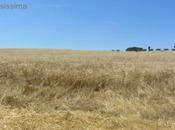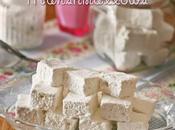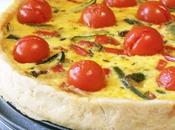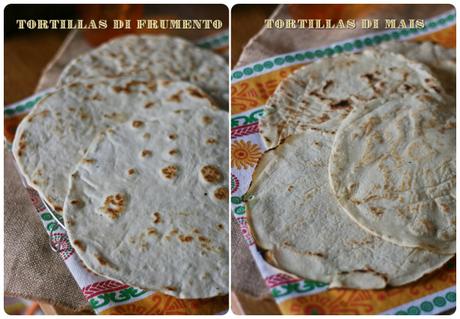
Ed eccoci arrivati all’ultimo giorno della tappa messicana dell’Abbecedario Culinario Mondiale e in quest’ultimo post racconterò dell’emblema della cucina messicana… le tortillas… e della mia odissea per arrivare a fare della tortillas di mais decenti!

(tutte le ricette messicane le trovate a casa della nostra ambasciatrice di Lucia di Torta di Rose che QUI le ha raccolte)
Ma andiamo per ordine! :) …come vi dicevo e credo molti sappiano, le tortillas sono davvero un simbolo della cucina messicana, sono parte integrante della storia di questo paese. Ora si trovano anche tortilla di frumento ma è la tortilla di mais la vera antenata di questi pani piatti che accompagnano quasi tutti i pasti messicani.
Le tortillas di mais venivano preparate sin dai tempi degli aztechi che le mangiavano un po’ come oggi, ripiene di carni vari, fagioli, verdure e immancabile peperoncino. Le tortillas di frumento sono arrivate solo secoli più tardi, dopo la scoperta dell’America e l’introduzione del grano nelle colture locali.
Un neofita della tortilla di mais potrebbe pensare che per fare delle tortilla di mais si potrebbe usare la nostra farina di mais, quella per polenta o la fioretto ma purtroppo non è così! In Messico, il mais per preparare le tortilla viene lavorato in una particolare maniera detta Nixtamalizzazione (Nixtamalization), che consiste nel trattare i chicchi di mais con acqua di calce (soluzione acquosa satura di idrossido di calcio). Questo processo, risalente anch’esso all’epoca precolombiana, oltre a rimuovere la pellicina esterna del chicco, lo rende molto più digeribile dall’organismo e arricchisce il mais di molti nutrienti, da numerose vitamine (come la vitamina B3 o niacina), minerali (tra i quali il calcio), aminoacidi (triptofano) e proteine.
Una volta trattato il mais viene frantumato, cotto e ridotto poi in un impasto morbido chiamato masa nixtamalera, che viene pressato e cotto su un comal, una teglia piatta, originariamente di terracotta ed ora di ghisa o altro metallo.
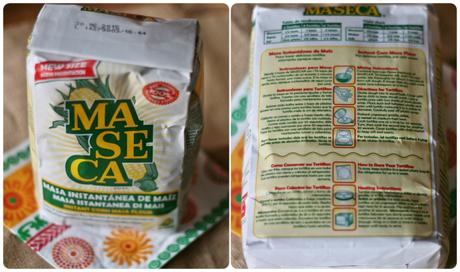
Ovviamente se uno vuole preparare delle tortilla in casa, senza partire dall’impasto di mais cotto, lo può fare usando la Masa Harina, ovvero una farina ottenuta dal mais trattato e cotto, seccato e ridotto in farina. La masa harina è quella che alla fine quasi tutti usano per fare le tortilla di mais in casa ma non è facilissima da reperire qui da noi.
Io per fortuna l’ho trovata nel mio negozio di fiducia, quello dove trovo tutte le spezie, le erbe ed altri ingredienti particolari e stranieri. Io felicissima di averla trovata ho scioccamente pensato che la tortillas di mais fossero ormai nelle mie mani… ma non è stato così facile farle!
L’impasto che si crea con questa farina, priva di glutine, non crea una maglia elastica ed è quasi impossibile stenderla con un mattarello, io c’ho provato ma si sfregola e si rompe. Le palline che si formano infatti, devono venir pressate con la tipica pressa da tortilla (che ora voglio assolutamente!!!) e cotte subito. Una volta cotte le tortilla sono molto meno fragili e si possono piegare senza problemi.
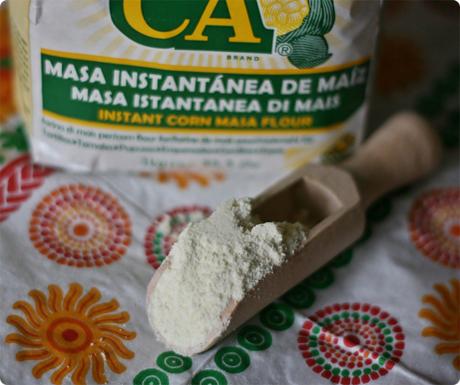
Così dopo aver preparato un impasto non troppo umido ma nemmeno troppo asciutto… come ovviare alla mia mancanza di pressa e riuscire a preparare delle tortillas decenti? …ho iniziato a pressarle tra due fogli di carta forno con una pentola sopra che imprimeva però anche il marchio che aveva sul fondo ;) e che comunque non mi appiattiva abbastanza le tortilla. Insomma… alla fine è intervenuto l’uomo di casa che ha risolto la situazione, prima trovando una pentola dal fondo piatto e poi salendo sopra una sedia per imprimere dall’alto più forza e pressione alla pentola… et voilà… le tortillas erano appiattite e pronte alla cottura.
Come ogni preparazione particolare e nuova bisogna farci un po’ la mano insomma, sia nell’avere un giusto impasto che nella pressatura e cottura. Io ho ancora un po’ di farina per far pratica ma prima voglio ordinare una pressa online… che di salire sopra a sedie e pentole non ne ho più voglia! ;) …credo poi che la pressa possa tornare utile per stendere anche altri impasti simili come le piadine, quindi potrà essermi molto utile! :)
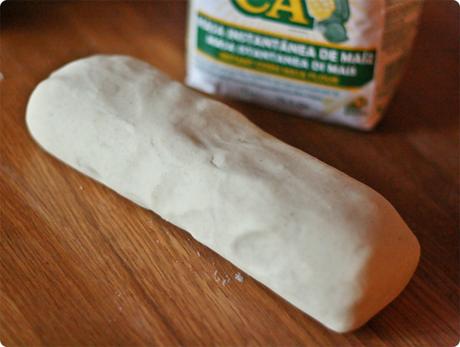
Oltre alle tortillas di mais ho anche preparato le tortillas di frumento che, come dicevo prima, furono introdotte in epoca post-colombiana. In Messico le tortillas di frumento sono molto usate nel Nord del Messico, oltre che negli USA negli stati limitrofi con il Texas e quindi per la famosa cucina tex-mex. Con le tortilla di frumento si preparano i burritos o le quesadillas. Le tortilla di mais invece si usano più negli stati centrali e meridionali del Messico e si usano per accompagnare i piatti, per fare la zuppa di tortillas, le tortilla chips, tacos, tostadas, enchilladas, flautas e quesadillas.
Il mondo delle tortillas è dei suoi vari ripieni è quindi davvero vasto ed ogni preparazione ha il suo modo di piegare le tortillas, di mais o di frumento ed ha i suoi ripieni ed a volte anche piccole differenze fanno cambiare il nome ad un piatto. Io l’ho scoperto con le quesadillas!
La quesadilla è fatta con una tortilla di mais (ma anche di frumento) che può essere farcita con vari ingredienti tra i quali però non deve mancare il formaggio, il queso da cui prende il nome. La tortilla per la quesadilla va scaldata, così da ammorbidirla, va farcita su una metà e piegata a mezzaluna e scaldata sulla piastra. Il formaggio tipico usato è l’oaxaca, un formaggio a pasta filata che io ho sostituito con della provola (tanto per restare su un formaggio a pasta filata). Nel nord del Messico oltre ad usare le tortilla di frumento viene usato anche il Monterey jack, un formaggio vaccino a pasta semidura.
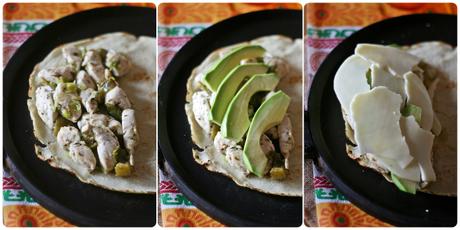
Spesso la quesadilla, una volta pronta viene tagliata a metà, in due spicchi e questo a volte l’ha fatta confondere con un altro piatto, la sincronizada anche perché spesso, quest’ultima, viene chiamata quesadilla al di fuori del Messico. Ma dove sta la differenza?… la differenza sta nella tortilla, sempre di frumento, nel fatto che la sincronizada non viene piegata ma la farcitura sta tra due tortillas che poi vengono tagliate a spicchi e poi in un ingrediente che non deve mai mancare nella sincronizada …il prosciutto, infatti la sincronizada classica è quella più semplice di formaggio e prosciutto.
Io, avendo fatto anche delle tortillas di frumento ed avendo tutto in frigo alla fine ho provato anche questa velocissima e semplice sincronizada.
Devo dire che l’impasto della tortilla di frumento mi ha ricordato molto la nostra piadina ed è bello trovare queste similitudini a migliaia di Km di distanza! …io ho usato lo strutto, molte ricette prevedono lo shortening (il più usato in America e in tanti altri stati limitrofi è quello tutto vegetale di marca Crisco) o volendo anche l’olio.
Un consiglio che vi do, se volete approcciarvi alle varie tortillas e capire al meglio la manualità, è quello di guardare un po’ di video su youtube, ce ne sono tanti, per entrambi i tipi di tortillas e di sicuro aiutano a capire la gestualità e a vedere bene le consistenze degli impasti.
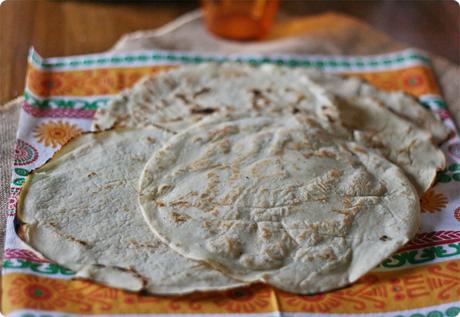
Tortillas di mais
- Per circa 7-8 tortillas:
- 250 gr di masa harina
- 1 cucchiaio d’olio d’oliva
- 1 cucchiaino di sale
- 300/350 ml di acqua
In una ciotola mettete la farina, il sale, versate al centro l’olio e pian piano l’acqua, iniziando ad impastare. Unite l’acqua un po’ per volta finchè non otterrete un impasto morbido, non appiccicaticcio ma nemmeno troppo secco altrimenti diventa sbricioloso. Formate delle palline e schiacciatele o con l’apposita pressa o mettendola tra due fogli di carta forno e pressandole sotto a delle pentole pesanti. Scaldate una teglia piatta, ottimo è il testo per piadine. Adagiatevi sopra la tortilla, con delicatezza e cuocetela qualche minuto per parte finchè iniziano a formarsi le macchioline scure. Le tortilla una volta cotte si possono conservare coperte in frigo per due o tre giorni e poi scaldate prima di farcirle o usarle come accompagnamento per i piatti.

Tortillas di frumento
- per circa 5 tortillas:
- 250 gr di farina
- 50 gr di strutto
- ½ cucchiaino di sale
- ¼ cucchiaino di lievito
- 120/150 ml di acqua
In una ciotola miscelata la farina con sale e lievito. Unite lo strutto e lavoratelo con le dite insieme alla farina, cercate di distribuirlo bene ed avere un composto sbricioloso. Unite pian piano l’acqua ed impastate fino ad ottenere una palla morbida. Lasciate riposare 15 minuti. Formate delle palline e stendetele tonde con un mattarello. Scaldate una piastra, tipo testo per piadine e cuocete le tortillas qualche minuto per lato finchè iniziano a formare delle macchioline scure. Le tortilla una volta cotte si possono conservare coperte in frigo per due o tre giorni e poi scaldate prima di farcirle.
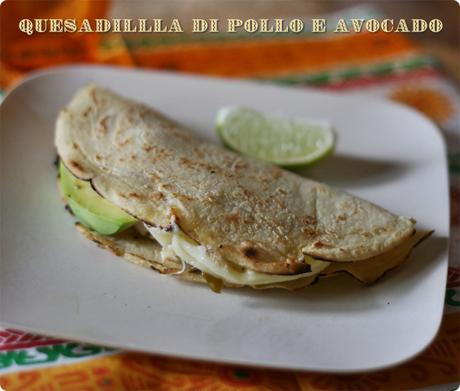
Quesadillas di pollo e avocado
- per 4 quesadillas:
- 400 gr petto di pollo, tagliato a pezzetti
- 3 cucchiai olio evo
- 2 cipollotti
- 6 jalapenos, affettati e senza semi
- 1 cucchiaio epazote
- sale
- 1 avocado, piccolo e tagliato a fettine
- 150 gr provola (o altro formaggio a vostra scelta)
- 4 tortillas di mais
Scaldare l’olio in una padella ed unire cipollotti e pollo. Saltare per 5 minuti, mescolando bene. Unite jalapenos, epazote e sale. Continuate la cottura per altri 5 minuti finchè il pollo sia bene cotto e brunito.
Scaldate le tortillas di mais su una teglia piatta finchè morbide. Farcirle su una metà con pollo, avocado e formaggio. Piegare la tortilla e scaldarla sulla teglia qualche minuto per lato, finchè ben calde ed il formaggio sia cotto.
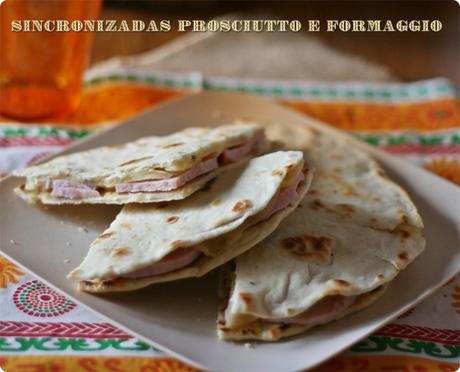
Sincronizadas al prosciutto e formaggio
- Per 2 porzioni:
- 2 tortillas di frumento
- 150 gr di formaggio a scelta
- 150 gr di prosciutto cotto
Scaldare le tortillas finchè calde e morbide. Farcite una tortilla con prosciutto e formaggio, coprite con la seconda tortilla e scaldatele sulla teglia finchè calde ed il formaggio sia fuso. Servite con salse a piacere (guacamole, panna acida, salsa piccante etc).

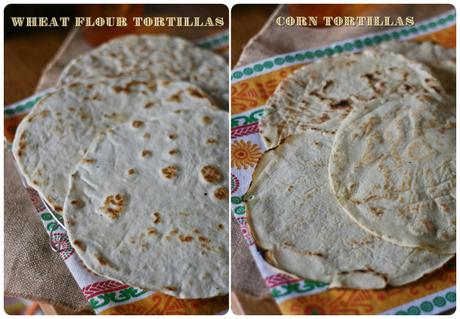
Tales of corn and wheat tortillas… of quesadillas and sincronizadas
And here we are at the last day of the Mexican stopover of the Culinary World ABC and in this last post I’ll tell you about a staple of Mexican food … the tortillas … and of my odyssey to make some decent corn tortillas!
But come to order! :) … as I said and I think many people know, the tortillas are real food staple of mexican cuisine and and an important part of the history of this country. Nowadays you can find even wheat flour tortillas but is the corn tortilla the ancestor of all the flat unleavened breads you eat along with most Mexican dishes.
Corn tortillas were prepared since Aztecs time and they were used to eat more or less as we used today, stuffed with meat , beans , vegetables and of course chillies. Wheat tortillas came only centuries later, after the discovery of America and the introduction of the grain in the local crops.
A newcomer to corn tortillas might think that, to make corn tortillas you could use our cornmeal but unfortunately it is not so easy! In Mexico , the corn to prepare the tortilla is processed in a particular way called Nixtamalization, which consists in treating corn kernels with limewater. This process, used since pre-Columbian era, removes the outer skins of the grain, making corn easier to digest and it enriches the corn of many nutrients, numerous vitamins (such as vitamin B3 or niacin), minerals (including calcium), amino acids (tryptophan) and proteins.
Once treated corn is crushed , cooked and then reduced to a soft dough called masa nixtamalera , which is pressed and cooked on a comal, originally a flat terra cotta griddle, now usually made of light sheet-metal instead.
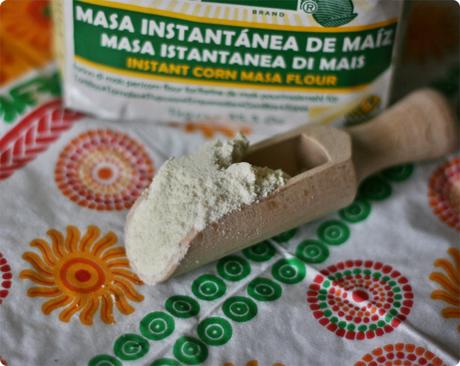
Obviously, if you want to prepare the tortillas at home, without having cooked nixtamaled corn, you can do it using the Masa Harina, a flour made from nixtamaled corn, dried and ground into flour. The masa harina is the one that eventually almost everyone uses to make homemade corn tortillas… but unfortunately it is not easy to find it over here.
I’ve been lucky to find masa harina in my local store, the one where I find all spices and herbs and other foreign ingredients . I was really happy to have found it and I foolishly thought that corn tortillas were now in my hands… but it has been harder than I thought!
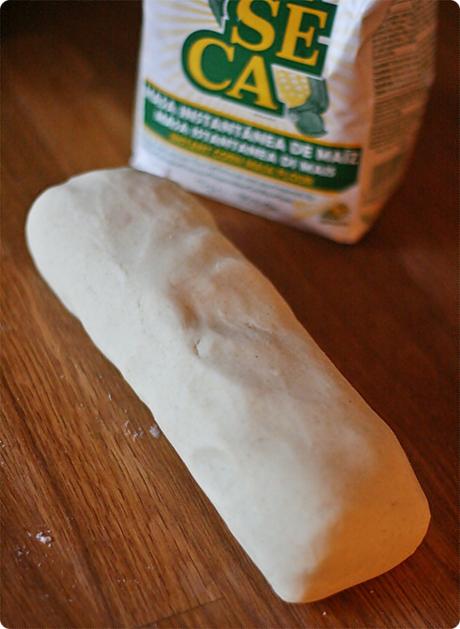
The mixture that is created with this flour, gluten-free, doesn’t create an elastic dough and it is nearly impossible to roll it out with a rolling pin, I tried but it was all cracked. The “secret” is that the dough balls should must be pressed with the typical tortilla press (which now I definitely want !!!) and cooked immediately. Once cooked tortillas don’t break and can be folded without problems .
So after having prepared a good tortilla dough (not too wet and not too dry)… how to overcome my lack of press and be able to prepare some decent tortillas? … I started pressing them between two sheets of parchment paper with a saucepan on top but it printed also the pan brand it had on the bottom ; ) and anyway I wasn’t able to flatten enough my tortillas. Well … finally my half came to help me and he solved the situation. He found a flat-bottomed saucepan and then climbing on a chair he pressed from above giving more strength and pressure the pan … and here they are … the tortillas were flattened and ready to be cooked.
Like any new and typical recipe it’s important to practice the technique many times in order to have the right dough consistence and to learn how to press it well and cook it properly. For sure I’ll buy a tortilla press online cos I don’t want to climb on chairs and pans anymore! ;) …and I think that the press will be handy also for similar flat breads, like the Italian piadina for example
In addition to corn tortillas I also prepared some wheat flour tortillas which, as I said before, were introduced in the post-Columbian period. In Mexico wheat flour tortillas are commonly used in the Northern Mexico, as well as in USA, especially in Texas and its famous Tex-Mex cuisine. With wheat flour tortillas you can make burritos or quesadillas. Corn tortillas instead are used in the central and southern states of Mexico and they’re served as an accompaniment to many dishes or to make soup of tortillas, tortilla chips, tacos, tostadas, enchilladas, flautas and quesadillas.
The tortilla world is really wide …many way to fold them and fill them and its way has its own name. Some uses corn tortillas, some wheat ones and even small differences can create a totally different dish! …and I discovered this quesadillas !
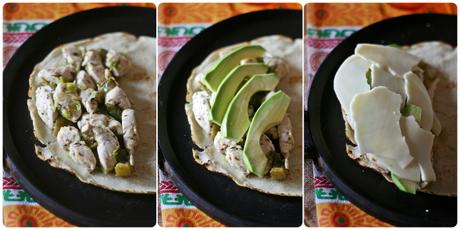
The quesadilla is made with corn tortilla (but also wheat ones can be used) and stuffed with various ingredients and the main one should be cheese, the queso from which it takes its name. To make quesadilla the tortilla is warmed to soften it enough to be folded in half, and then filled. The typical cheese used is the Oaxaca cheese, a stretched curd cheese (like mozzarella) that I substituted with provola (another stretched curd cheese). In northern Mexico quesadilla are made with wheat tortillas and they use the Monterey jack , a semi-hard cow’s milk or cheddar.
Often the quesadilla, once ready is cut in half and sometimes it’s confused with another dish called sincronizada which is usually called quesadilla outside Mexico. But where is the difference? …There more than one difference, sincronizadas use always wheat tortillas, they’re not folded but the filling is between two tortillas which are then cut into wedges and then the main ingredient that should never miss is ham. The most classic sincronizada is the simple cheese and ham one.
As I made some wheat tortillas and I had all ingredients in the fridge, I also tried this fast and simple sincronizada.
I must say that the ingredients of wheat tortillas reminded me very much our piadina and it is nice to find these similarities in so distant cuisines! …I used lard, but many recipes use shortening or vegetable oil.
I suggestion, if you want to make your own tortillas, corn or wheat ones, is to watch some vidoes on youtube, there are many, for both types of tortillas and certainly they’ll help you to understand the gestures and to see how the right dough should be like.
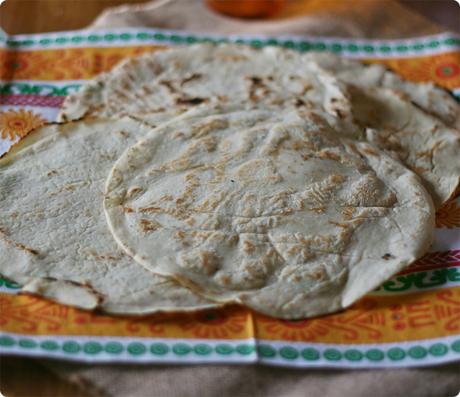
Corn tortillas
- For about 7-8 tortillas:
- 250 gr masa harina
- 1 tbsp olive oil
- 1 tsp salt
- 300/350 ml water
In a bowl mix flour and salt. Add oil in the middle and start kneading, adding water until you get asmooth dough, not too wet and not to dry and crumbly. Shape some little balls and press them with a tortilla press or in between two wax paper sheets with an heavy saucepan on top. Cook tortillas on a hot griddle few minutes on each sides until brown spots appear on the surface. You can store tortillas, wrapped, in fridge for 2 or 3 days and warm them before using them.
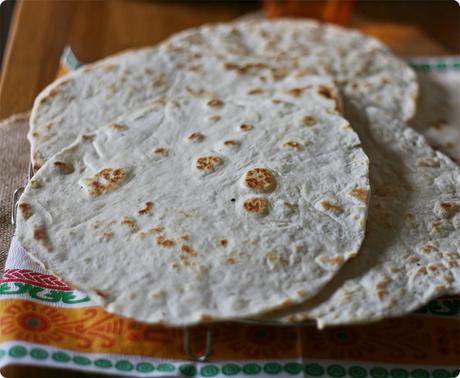
Wheat flour tortillas
- For about 5 tortillas:
- 250 gr all-purpose flour
- 50 gr lard (or shortening or vegetable oil)
- ½ tsp salt
- ¼ tsp baking powder
- 120/150 ml water
In a bowl mix flour with salt and baking powder. Add lard and work it with flour using fingertips until you get a crumbled mixture. Pour water and work the mixture until you get a smooth dough. Let it rest for about 15 minutes. Shape some balls and roll them out in circles. Cook tortillas on a hot griddle few minutes on each sides until brown spots appear on the surface. You can store tortillas, wrapped, in fridge for 2 or 3 days and warm them before using them.
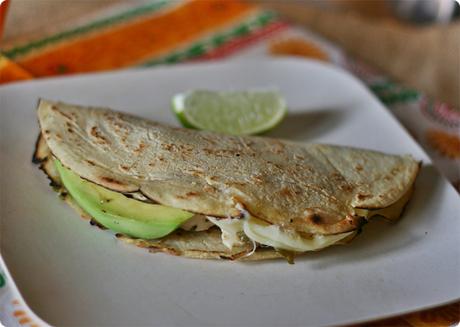
Chicken and avocado quesadillas
- for 4 quesadillas:
- 400 gr chicken cut in small pieces
- 3 tbsp olive oil
- 2 spring onions
- 6 jalapenos, sliced and seeds removed
- 1 tbsp epazote
- salt
- 1 small avocado, sliced
- 150 gr provola cheese (or oaxaca cheese or another cheese at your choice)
- 4 corn tortillas
Heat olive oil in a pan add apring onions and chicken and cook for about 5 minutes, stirring well. Add epazote, jalapenos, salt and continue cooking for about 5 minutes, until chicken is brown and cooked through.
Heat tortillas on a griddle until warm and soft. Fill them on one half with some chicken, avocado slices and cheese. Fold tortilla and cook it on the griddle, few minutes on each side until hot and cheese melts.
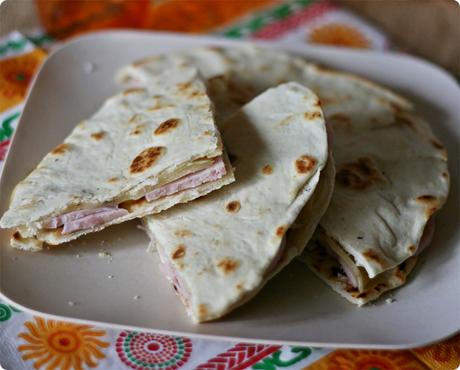
Ham and cheese sincronizadas
- for 2 portions:
- 2 wheat flour tortillas
- 150 gr ham
- 150 gr cheese at your choice (I used provola)
